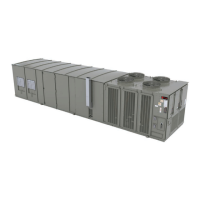
Do you have a question about the Trane IntelliPak 1 and is the answer not in the manual?
| Brand | Trane |
|---|---|
| Model | IntelliPak 1 |
| Category | Air Conditioner |
| Language | English |
Defines and explains the three types of advisories: Warning, Caution, and Notice for safe operation.
Outlines Trane's advocacy for responsible refrigerant handling and compliance with regulations.
Defines the first digit of the model number for identifying the unit type.
Defines the second digit of the model number for specifying the unit's function.
Defines digits 5, 6, and 7 to indicate the unit's nominal capacity in tons.
Defines the ninth digit of the model number for various heating capacity options.
Defines the seventeenth digit for specifying the unit's system control type.
Defines the twenty-sixth digit for specifying the unit's efficiency options.
Describes the location and information found on the unit's Mylar nameplate.
Provides a general overview of the single-zone rooftop air conditioner unit.
Instructions for inspecting the unit for damage upon receipt and verifying documentation.
Steps for visually inspecting the unit's exterior for shipping damage and shortages.
Details minimum operating and service clearances required for unit installation.
A summary checklist of essential steps for installing a commercial rooftop unit.
Key requirements for verifying power supply, grounding, and wiring connections.
Guidance for completing field wiring for VAV controls, ensuring NEC compliance.
Specific wiring and connection requirements for units equipped with electric heat.
Specific installation requirements for units featuring gas heat.
Table detailing unit dimensions for various heating/cooling configurations and models.
Diagram illustrating unit dimensions for SAH_ cooling-only units (20-75 ton).
Table providing specific unit dimensions for SAH_ cooling-only units (20-75 ton).
Diagram illustrating unit dimensions for SEH_, SFH_, SLH_, SSH_, SXH_ units (20-75 ton).
Illustrates minimum clearances for single unit operation and service access.
Shows minimum required clearances for multiple unit installations.
Instructions and considerations for installing roof curbs and ductwork.
Guidance on locating and installing pitch pockets for electrical power entry.
Steps for setting the unit on the curb, checking seals, and connecting drains.
Table of operating weights and roof curb weights for older units.
Warning about using R-410A refrigerant and specific service equipment.
Safety precautions and first aid measures for working with fiberglass wool insulation.
Guidance on electrical connections, emphasizing safety precautions.
Describes the unit's operational modes: Stopped, Auto, Occupancy, and Timed Override.
Defines Occupied, Unoccupied, Bypass, and Standby operating states.
Provides supply fan performance curves for various unit sizes and configurations.
Graph showing wet airside pressure drop for evaporator coils (20-75 ton).
Graph showing dry airside pressure drop for evaporator coils (20-75 ton).
Table detailing static pressure drops for various components and unit sizes.
Performance data for modulating 100% relief fans (20-75 tons).
Instructions for verifying and adjusting exhaust damper closure.
Explains operation and linkage of outside and return air dampers.
Steps to measure system subcooling using pressure/temperature charts.
Explains low ambient function using variable speed condenser fans.
Importance of air/fuel mixture for safe and efficient furnace operation.
How the ultra modulating furnace unit is controlled by sensors and Symbio.
Procedure for adjusting low fire O2 levels and checking flame appearance.
Procedure for adjusting high fire O2 levels and checking flue gas composition.
Checklist items for general startup procedures before unit operation.
Checks for system airflow, damper operation, and compressor performance.
Continuation of the startup checklist for 20-75 ton units.
Startup checklist items for 90-130 ton air-cooled units.
Table of critical control parameters and suggested settings for economizer.
Safety warnings regarding hazardous voltage and UV radiation exposure.
Guidance on identifying and replacing compressor circuit breakers.
Information on supply and relief/return fan motor overloads.
Diagram illustrating how to use a belt tension gauge for proper belt adjustment.
Warning about R-410A refrigerant pressure and required service equipment.
Warning about high pressure refrigerant and potential explosion hazard.
Procedures for draining and charging oil for CSHD and CSHN compressors.
Information on the precision suction restrictor used in tandem compressors.
Steps to reset VFD programming parameters to factory defaults.
Guidance on verifying programmed VFD parameters before replacement.
Instructions for inspecting, cleaning, or replacing air filters.
Safety warning regarding hazardous voltage before performing checks.
Safety warning about rotating components during servicing.
Steps for checking condenser fan movement and bearings.
Procedures for checking, repairing, or replacing supply fan motor bearings.
Recording operational data like ambient temperature, oil level, and pressures.
Safety warning regarding hazardous voltage before performing checks.
Instructions for inspecting and cleaning/replacing air filters for heating season.
Instructions for cleaning refrigerant coils using soft brush and sprayer.
Safety warning regarding falling off equipment during servicing.
A matrix listing diagram numbers and their names for unit wiring.
Warranty coverage details for commercial equipment rated 20 tons and larger.
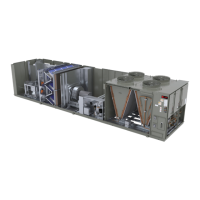
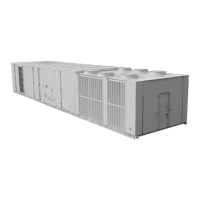
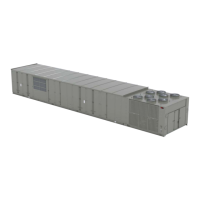
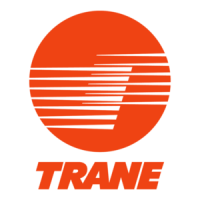

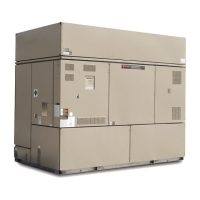
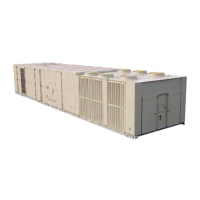

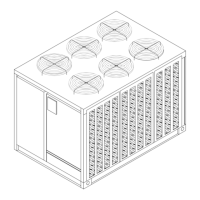


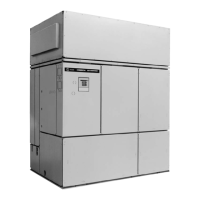
